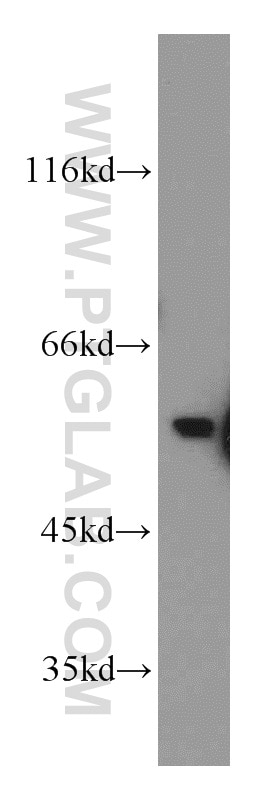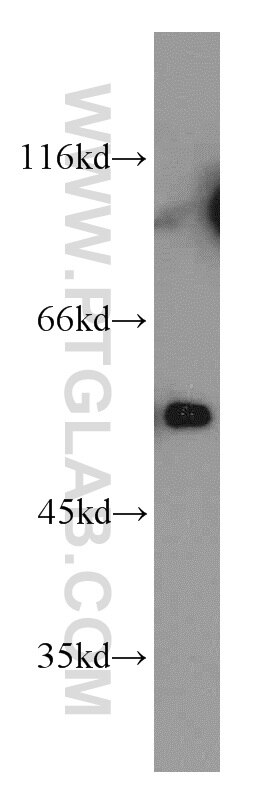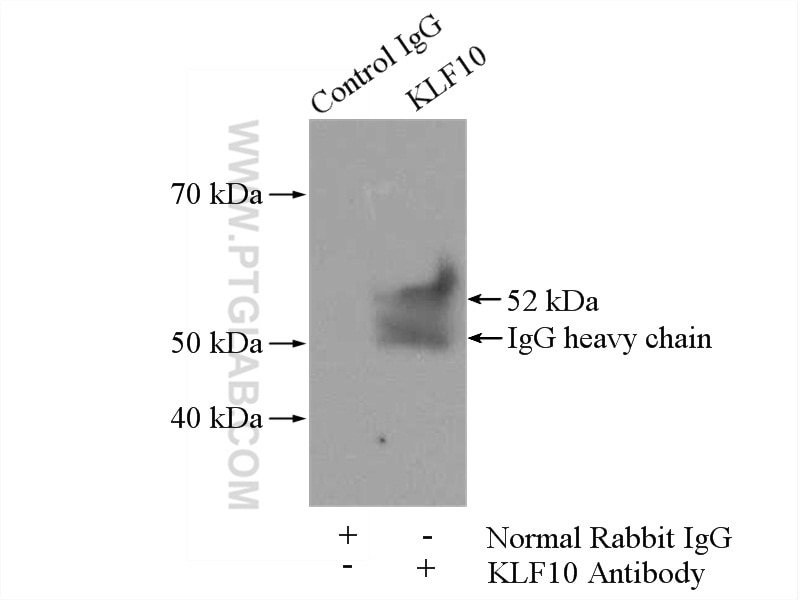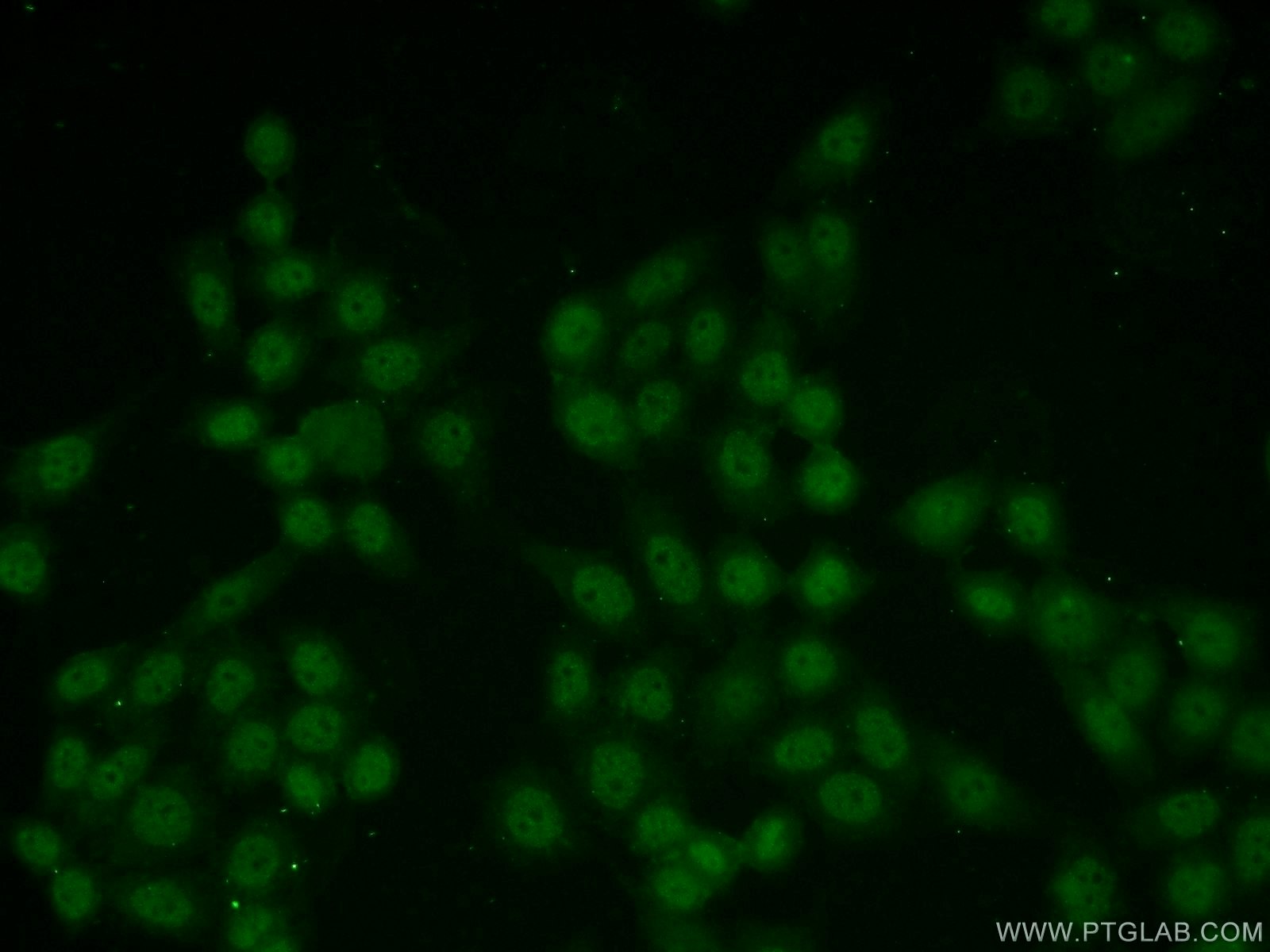KLF10 Polyklonaler Antikörper
KLF10 Polyklonal Antikörper für WB, IP, IF, ELISA
Wirt / Isotyp
Kaninchen / IgG
Getestete Reaktivität
human und mehr (2)
Anwendung
WB, IP, IF, IHC, Chip, ELISA
Konjugation
Unkonjugiert
Kat-Nr. : 11881-1-AP
Synonyme
Geprüfte Anwendungen
| Erfolgreiche Detektion in WB | HeLa-Zellen, Jurkat-Zellen |
| Erfolgreiche IP | Jurkat-Zellen |
| Erfolgreiche Detektion in IF/ICC | HeLa-Zellen |
Empfohlene Verdünnung
| Anwendung | Verdünnung |
|---|---|
| Western Blot (WB) | WB : 1:200-1:1000 |
| Immunpräzipitation (IP) | IP : 0.5-4.0 ug for 1.0-3.0 mg of total protein lysate |
| Immunfluoreszenz (IF)/ICC | IF/ICC : 1:20-1:200 |
| It is recommended that this reagent should be titrated in each testing system to obtain optimal results. | |
| Sample-dependent, check data in validation data gallery | |
Veröffentlichte Anwendungen
| WB | See 2 publications below |
| IHC | See 1 publications below |
| IF | See 2 publications below |
| ChIP | See 1 publications below |
Produktinformation
11881-1-AP bindet in WB, IP, IF, IHC, Chip, ELISA KLF10 und zeigt Reaktivität mit human
| Getestete Reaktivität | human |
| In Publikationen genannte Reaktivität | human, Hund, Maus |
| Wirt / Isotyp | Kaninchen / IgG |
| Klonalität | Polyklonal |
| Typ | Antikörper |
| Immunogen | KLF10 fusion protein Ag2482 |
| Vollständiger Name | Kruppel-like factor 10 |
| Berechnetes Molekulargewicht | 469 aa, 51 kDa |
| Beobachtetes Molekulargewicht | 51 kDa |
| GenBank-Zugangsnummer | BC011538 |
| Gene symbol | KLF10 |
| Gene ID (NCBI) | 7071 |
| Konjugation | Unkonjugiert |
| Form | Liquid |
| Reinigungsmethode | Antigen-Affinitätsreinigung |
| Lagerungspuffer | PBS with 0.02% sodium azide and 50% glycerol |
| Lagerungsbedingungen | Bei -20°C lagern. Nach dem Versand ein Jahr lang stabil Aliquotieren ist bei -20oC Lagerung nicht notwendig. 20ul Größen enthalten 0,1% BSA. |
Hintergrundinformationen
KLF10 (Krueppel-like factor 10), also known as TIEG1, is a transcription factor that plays a role in the regulation of cell growth. It binds to the consensus sequence 5'-GGTGTG-3'. KLF10 plays a role in the response to TGFbeta (through the TGFbeta/Smad signalling pathway) and estrogen. In both cases, KLF10 induces or repressed gene transcription to enhance the TGFbeta/Smad signalling pathway, as well as other pathways, to regulate cell proliferation, differentiation and apoptosis. KLF10 has been shown to have a role in skeletal disease (osteopenia/osteoporosis), hypertrophic cardiomyopathy, and breast and prostate cancer.This antibody is a rabbit polyclonal antibody raised against a full-length human KLF10 protein, and specifically recognizes the 52kd KLF10 protein.
Protokolle
| PRODUKTSPEZIFISCHE PROTOKOLLE | |
|---|---|
| WB protocol for KLF10 antibody 11881-1-AP | Protokoll herunterladen |
| IF protocol for KLF10 antibody 11881-1-AP | Protokoll herunterladen |
| IP protocol for KLF10 antibody 11881-1-AP | Protokoll herunterladen |
| STANDARD-PROTOKOLLE | |
|---|---|
| Klicken Sie hier, um unsere Standardprotokolle anzuzeigen |
Publikationen
| Species | Application | Title |
|---|---|---|
Sci Rep Polymorphism rs7278468 is associated with Age-related cataract through decreasing transcriptional activity of the CRYAA promoter. | ||
J Mol Cell Cardiol Cellular heterogeneity and immune microenvironment revealed by single-cell transcriptome in venous malformation and cavernous venous malformation. | ||
Acta Histochem KLF10 is upregulated in osteoarthritis and inhibits chondrocyte proliferation and migration by upregulating Acvr1 and suppressing inhbb expression. | ||
Cell Death Discov Downregulation of KLF10 contributes to the regeneration of survived renal tubular cells in cisplatin-induced acute kidney injury via ZBTB7A-KLF10-PTEN axis | ||
Cell Signal Mammalian cleavage factor 25 targets KLF14 to inhibit hepatic stellate cell activation and liver fibrosis |





